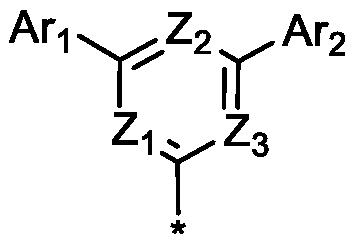Organic compound and organic electroluminescent device using same
A compound and organic technology, applied in the field of organic electroluminescent elements, can solve problems such as poor thermal stability, low glass transition temperature, and unsatisfactory service life of light-emitting elements, and achieve excellent luminous ability and improved efficiency. Effect
- Summary
- Abstract
- Description
- Claims
- Application Information
AI Technical Summary
Problems solved by technology
Method used
Image
Examples
Synthetic example 1
[0173] [Synthesis Example 1] Synthesis of Compound 1
[0174]
[0175] PPY-1 3.0g and (4-(4,6-diphenyl-1,3,5-triazin-2-yl)phenyl)boronic acid 3.4g, tetrakis(triphenylphosphine)palladium(0) 500 mg and 15 ml of a 2M potassium carbonate aqueous solution were added to 60 ml of toluene, 12 ml of ethanol, and 12 ml of water, followed by heating under reflux and stirring for 2 hours. The temperature was lowered to normal temperature, and after the reaction was completed, the potassium phosphate solution was removed, the layers were separated and distilled under reduced pressure, and purified by gel column chromatography (using dichloromethane alone) to produce compound 1 (2.3 g, yield 55%) .
[0176] Quality: [(M+H) + ]:617
Synthetic example 2
[0177] [Synthesis Example 2] Synthesis of Compound 3
[0178]
[0179] In the above Synthesis Example 1, except that PTZ-1 was used instead of PPY-1, Compound 3 (2.7 g, yield 53%) was produced in the same manner.
[0180] Quality: [(M+H) + ]:618
Synthetic example 3
[0181] [Synthesis Example 3] Synthesis of Compound 6
[0182]
[0183] In the above synthesis example 1, PPY-2 was used instead of PPY-1, and ID-1 was used instead of (4-(4,6-diphenyl-1,3,5-triazin-2-yl)phenyl ) boronic acid, Compound 6 (2.9 g, yield 56%) was produced in the same manner.
[0184] Quality: [(M+H) + ]:503
PUM
 Login to View More
Login to View More Abstract
Description
Claims
Application Information
 Login to View More
Login to View More - R&D
- Intellectual Property
- Life Sciences
- Materials
- Tech Scout
- Unparalleled Data Quality
- Higher Quality Content
- 60% Fewer Hallucinations
Browse by: Latest US Patents, China's latest patents, Technical Efficacy Thesaurus, Application Domain, Technology Topic, Popular Technical Reports.
© 2025 PatSnap. All rights reserved.Legal|Privacy policy|Modern Slavery Act Transparency Statement|Sitemap|About US| Contact US: help@patsnap.com



